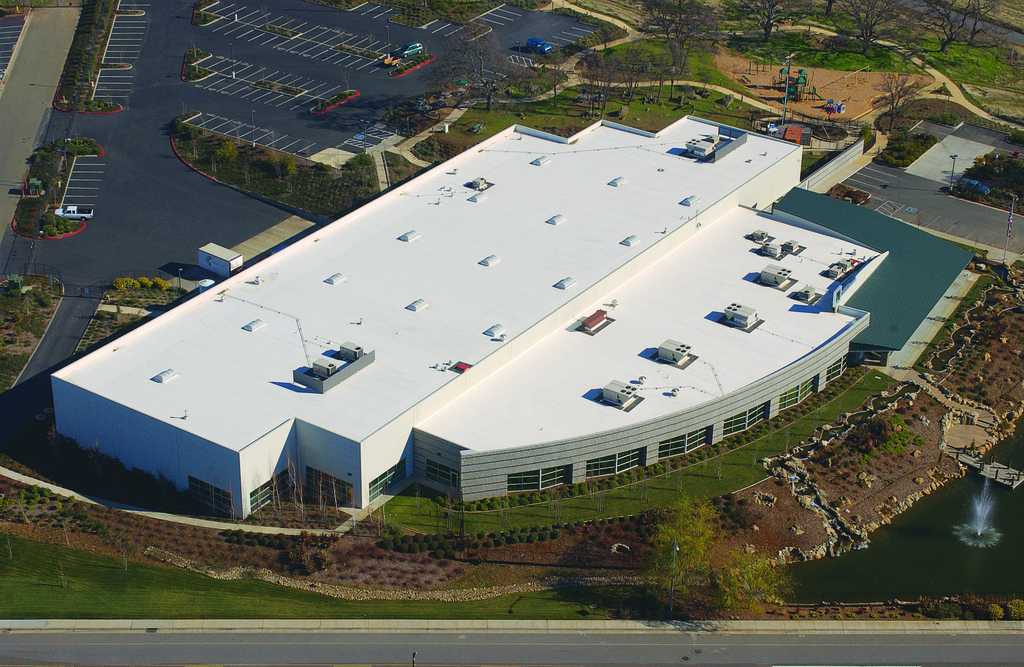PVC
While it is true that PVC is a relatively hard substance, the PVC that is used for roofing material has the benefit of plasticizers, which are added to make the membrane more pliable. Most PVC membranes are mechanically-attached, though fully-adhered or even ballasted PVC roofing systems are still occasionally found. What is almost universal, though, is that the PVC membranes are heat-welded at the seams. This creates a monolithic structure that is very durable and able to withstand the constant expansion and contraction of the building structure throughout the day, throughout its life. A properly heat-welded seam is a much better seam than a glued or taped seam. And the reason why PVC membranes are most often heat-welded at the seams is because of the strength, durability, and stability of the material itself which, unlike TPO, is very difficult to heat-weld properly because of the inferior quality of the membrane.
Though the PVC membrane has excellent puncture and heat resistant qualities, it is absolutely incompatible with asphalt-based products. So any time a PVC roof is to be installed in such a way as to come in to contact with any asphaltic product, separator sheets must be installed to keep the PVC from directly contacting the asphalt.
PVC is relatively light and can be purchased in milages between 36 and 90 mils (as mentioned before, a mil is 0.001 of an inch; 45 mils equal 0.045 inches). However, the standard PVC roofing membrane is about 50 mils. Though the primary color of a PVC roofing membrane is white, it can come in a variety of colors and hues. It also has excellent resistance to bacterial growth, animal fats, as well as plant root penetrations.
Though PVC is usually a roll good system (meaning, it is ordered in 5- to 12-foot wide by 50- to 100-foot long rolls), it is not the nightmare that TPO is. As mentioned before, PVC seams are usually heat-welded. And because of the structural integrity of the membrane, this heat-welding can go relatively quickly and with a much better result than that of TPO.
However, it is important to note that there is a PVC roof system manufacturer out there that actually custom prefabricates the membrane. This means that your roof is measured, including your curbs, walls, penetrations, etc., and then the roof is custom-designed to fit those dimensions. Such a methodology allows for all the benefits of larger sheet sizes as seen with EPDM, but with the added benefit of prefabricated curbs, walls, and penetrations. Your new roof is designed specifically for the size and constraints of real-world existing conditions.
This prefabrication process also eliminates up to 85% of all the field seams. As you may recall, seams are the weakest link in any roofing system. By having about 85% of those seams already completed by the manufacturer in their quality-controlled environment, your roof is going to be significantly enhanced. Having an authorized contractor like RTN Roofing Systems to install such a roof really gives you the best of both worlds.
While most other roofing products can come in either reinforced or non-reinforced material, PVC is often reinforced right out of the box. Reinforcement typically indicates a polyester scrim, mat, or fabric mesh that is inserted into the material, like rod iron is used to reinforce roads or concrete walls. While some manufacturers’ reinforcement may be better than others, it’s good to know that there is a little more structural integrity from the get-go with a PVC roofing membrane. This reinforcement, which translates to quality, is one of the reasons why PVC is a little more expensive than TPO, though it is still competitively priced against EPDM. If overall quality is the criterion used to decide what your next roofing system would be, then PVC should be at the top or your list.

